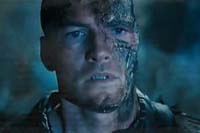 By: C.W. Marshall - May 25 2009
By: C.W. Marshall - May 25 2009
"What is it that makes us human?" asks John Connor in the closing minutes of Terminator: Salvation. The film's only answer, however, disappoints: if being human is not something that can be put in a chip, is it at least something we can identify when we see it? Nothing Salvation presents has the eeriness found in the previous Terminator films: we're never in doubt about who's human, and the machines (from the Transformers-inspired Harvesters to the Anaconda-inspired hydrobots) never cross the Uncanny Valley. The one human being kept alive by Skynet technology finds no difficulty in making a loving self-sacrifice as he fights for the Resistance. Turns out the Tin Man had a heart all along.
Philosophers and theologians struggle to identify what it is about being human that makes us special, but the best answers to this question usually come from science fiction. Prosthetics and transplants don't corrupt our humanity. Donna Haraway used cyborgs as a metaphor to push us into post-humanity, but her approach, while useful for feminism, is less so for understanding what is offered by science fiction. If we are all post-human anyway, then it becomes simply a matter of applying new labels, not pointing to our essence. The pirate with a peg-leg is still human, as is the person with a heart transplant or a cochlear implant.
Technological advance shows us this is a sliding scale. As more becomes possible, the definition slips. Modern science pushes the viability of the human fetus earlier and earlier, and many techniques are used to prolong old age. We are allowed to maintain ourselves in this way, but is there a hard limit? Both Luke and Anakin get robotic hands, but they stay human, and it seems a parasite is responsible for their Force powers. In 1973, the government spent $6 million to rebuild Steve Austin's legs, arm and eye. Though he's bionic, there's no doubt he's still human: same brain, same personality, still an upright biped with opposable thumbs; just an embodiment of an Olympic ideal: "better, stronger, faster."
Robocop (1987) pushes this thought experiment further. Murphy has flat-lined, and the corporate exec responsible (who is evil, naturally--this was the 80s) insists that the armored cyborg his company has created out of Murphy's brain, a few sustaining organs and his face "doesn't have a name. He has a program. He's product." But the film denies this: as memories emerge from his earlier life, Murphy expresses regret, overcomes his robotic programming, and reclaims his name. This is a much more agonizing struggle than that faced by Marcus Wright in Salvation: Wright has lost nothing from his former life; Murphy everything.
An organic body seems crucial to the limit we are exploring. HAL in 2001: A Space Odyssey (1968) may be sentient, but he is always just a computer. Nor do aliens challenge what is human. Though they are often used as metaphors for human diversity, they're still not us unless they have our 23 chromosomal base pairs.
Star Trek (1966, rebooted 2009) presents Spock as a liminal example of what is human. Spock's human mother waters down the purity of the test case, but as a Vulcan, any humanity ascribed to him is only through a generous (human) act of inclusion. Spock denies his humanity, and though Kirk can call him human (sometimes as a compliment, sometimes as a provocation) he is not doing so with philosophical rigor. If we judge what is human by behavior--irrationality, emotional outbursts, or a proclivity for one-night stands--then being human reduces again to mere metaphor.
Terminator (1984) understood this problem. Though Terminators are called cyborgs, they don't press the limit of what's human. Their organics are only cosmetic. Schwarzenegger-shaped skin serves only as a mask for deception and infiltration, and doesn't impact the robot's programming. Compare the fleshy grafts Data receives from the Borg in Star Trek: First Contact (1996), which begin a horrific seduction as Data's organic replacement parts grant deep human sensations. The appearance of the Terminators enters the Uncanny Valley: all surface, but wrong, because what's beneath, both literally and metaphysically, is not us.
In Battlestar Galactica (2003) Cylon "skin jobs" are genetically indistinguishable from humans, even though they have "evolved" from inorganic, human-created robots. Cylons pass for humans (glowing spines excepted), even if the last half of season four removed the most interesting aspects of this causational chain from human to robot to synthetic organic being. This echoes the role of the replicants in Blade Runner (1982), where the aim was, according to the motto of the Tyrell Corporation, to be "More Human Than Human."The current BSG prequel, Caprica, reveals the origin of the first Cylon: a dead teenage girl whose memories have been digitized and downloaded into a robotic shell.




